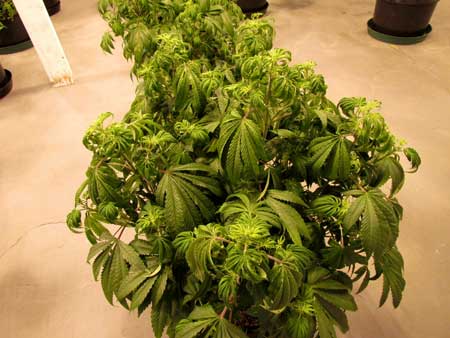Overwatering is mainly an issue for soil or substrate-based media the reason for the effects can be also seen in hydro but since it’s so unlikely we will only talk about overwatering/overfeeding your soil-based plants. Overwatering Is not always a result of simply watering to much but more that you have been watering too often.
The Signs
If after watering you notice a seemingly healthy plant starting to look unhealthy, leaves starting to drop or wain and an overall lack of vigor, you maybe overwatering. The initial issue is that oxygen is essential for a healthy and biologically diverse media, which in turn feed your roots. Your roots also uptake oxygen so a lack of oxygen tends to adversely effects your roots health. Even chelated based nutrients as they degrade require synthesis by beneficial microbes and bacteria in your media to be made available for your plants to use, although if feeding correctly this happens at a minimal rate.
Symptoms to look for:
- Plants leaves begin to fade and show signs of nutrient issues
- Leaves will appear droopy or waning after watering
- Your old and new growth will have curled leaves
- Overall lack of vigor
- Soil pH imbalances/swings
When your media is over saturated for periods of time the oxygen that exist within the media becomes depleted. This creates an anerobic environment where little to no available oxygen exist. Your media’s aeration is important, which is why growers include perlite or use inert based media like Grodan cubes to improve your medias aeration. The main function of oxygen in your soil media is to supply Oxygen to roots and feed the beneficial’s that in turn make other unavailable nutrients available for your plants to use. This has a dual effect in that there is less aeration in your soil preventing proper respiration and beneficial’s also quickly consumed any and all available oxygen. The byproduct of this being the accumulation of organic acids and hydrogen sulfide that are toxic for your roots and raise and/or lower your pH.
The Optimal aerobic media environment differs from plant to plant and media types but in soil you never want it to be completely saturated. The process of feeding or applying teas/drenches must be done with care to how much water a media can hold and how often you need to feed. A plant that eats less will still need the same nutrients levels but since it requires less water it also requires fewer watering’s. And adversely a healthier plant will eat more and require more food as well as more watering’s. Overwater can affect either with ease if care is not taken to your soil’s health and aeration. Soils with heavy amounts of organic elements often have issues with aeration/density and because of the normally high amount of soil diversity/activity oxygen depletion and overwatering can happen easily


Poor drainage has had a negative effect for the plant below:
Its lack of soil aeration will eventually kill this plant if left unchecked. If you see your plant is water logged do your best to remove the media from its container and apply an absorbent material to the to its borders and wick away as much water as possible. Check for lack of or clogged holes in your pots and water less often with a higher concentration of nutrients to offset any soil aeration issues or temporary problems with containers.
How to water cannabis properly
Every media has a different optimal saturation levels, most of which will have a direct correlation to the media’s aeration and oxygenation.
When watering a plant, you are applying a nutrient rich solution or maybe just water and sometimes a soil treatment. No matter what to reason care to your media is necessary to maintain health and optimal growth in all stages of life.
Here are some watering tips:
- Wait until the top of the growing medium is dry about an inch deep (up to your first knuckle)
- Pay attention to your plants water/nutrient intake to get an idea of how often to water/feed/apply
- Often growers will lift the pots to gain an idea of how saturated it is
Water until you see around 15-20% run off, this has the effect of flushing your soil of its byproducts and stagnant air, rejuvenating it as well as removing unused/unavailable nutrients.
If your plant medium seems to stay wet for a long period of time (more than 5 days or so), you may need better drainage. This also can happen when growers put tiny plants in a pot that’s way too big. Just water less and if you need to add aeration to your soil sooner is always better.
If you notice water Is not draining freely from your media containers manually add holes near the lowest points to improve drainage. Also, more airflow and higher temperatures will create more respiration just be sure not to raise media temps to high to long or force to much air over your plants leaves in turn damaging them.
Need more help?
If your plant is experiencing “the claw” and not just normal drooping (the ends of leaves are curling like a claw or pointing down like talons), then you may actually have a nutrient issue, too much nitrogen.
These Plants Are NOT Overwatered, the leaves pictures here show Signs of “The Claw” which usually indicates an issue with nitrogen.










